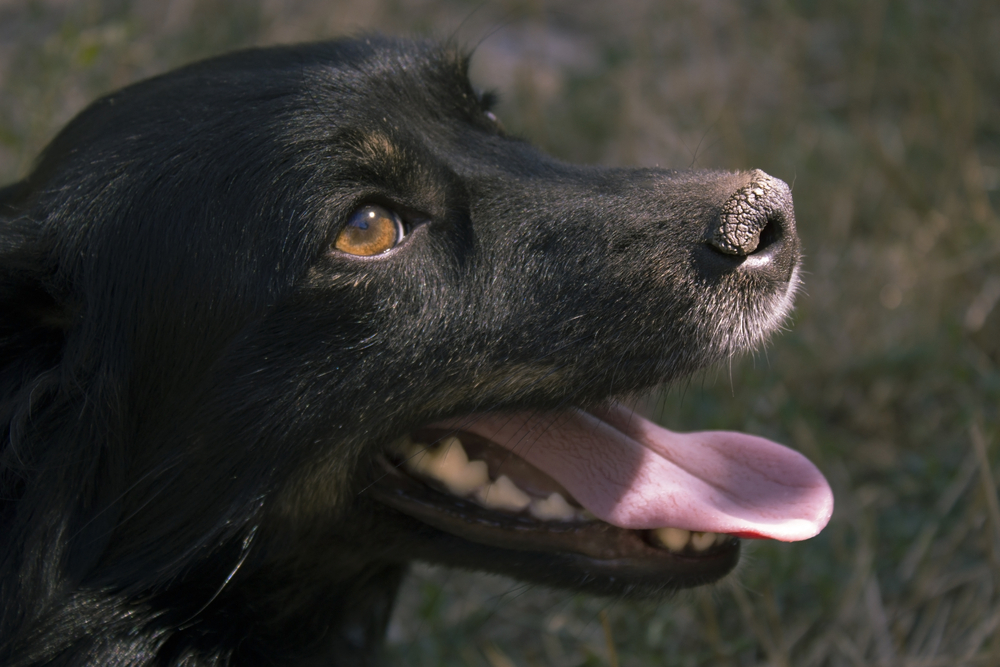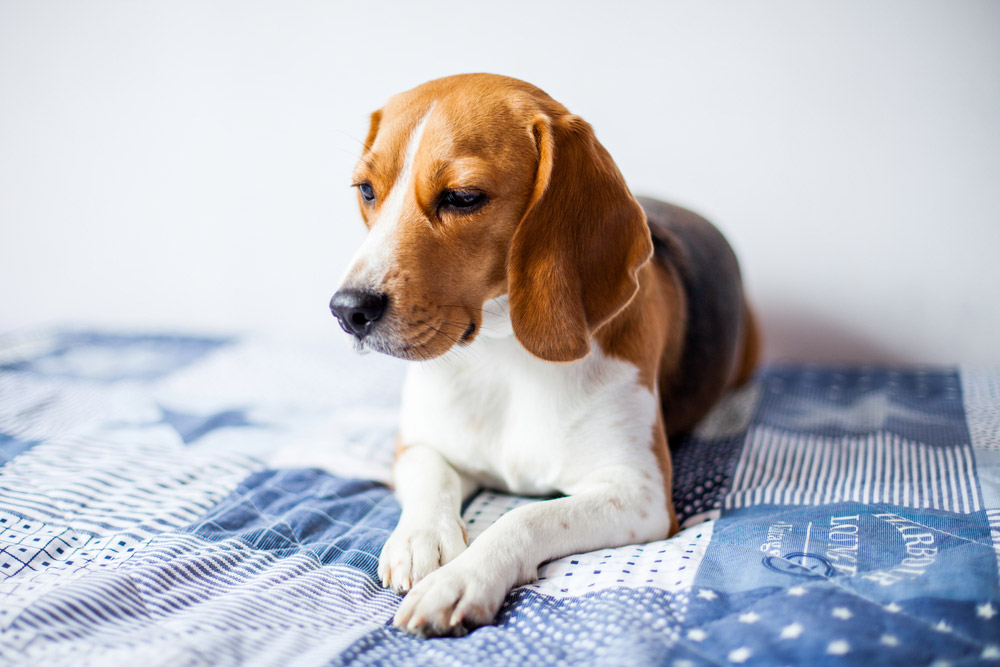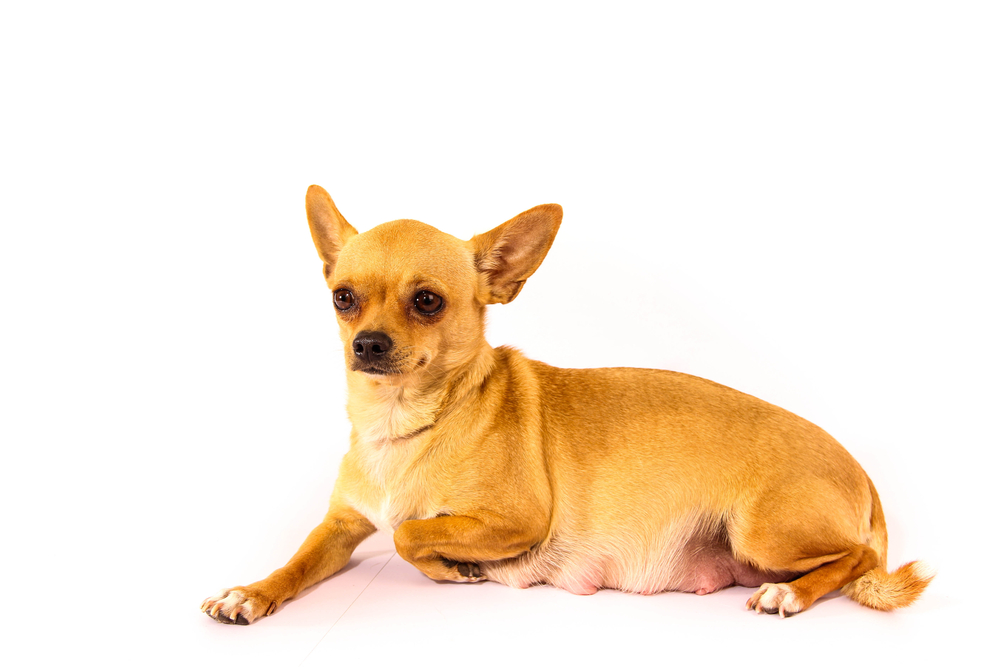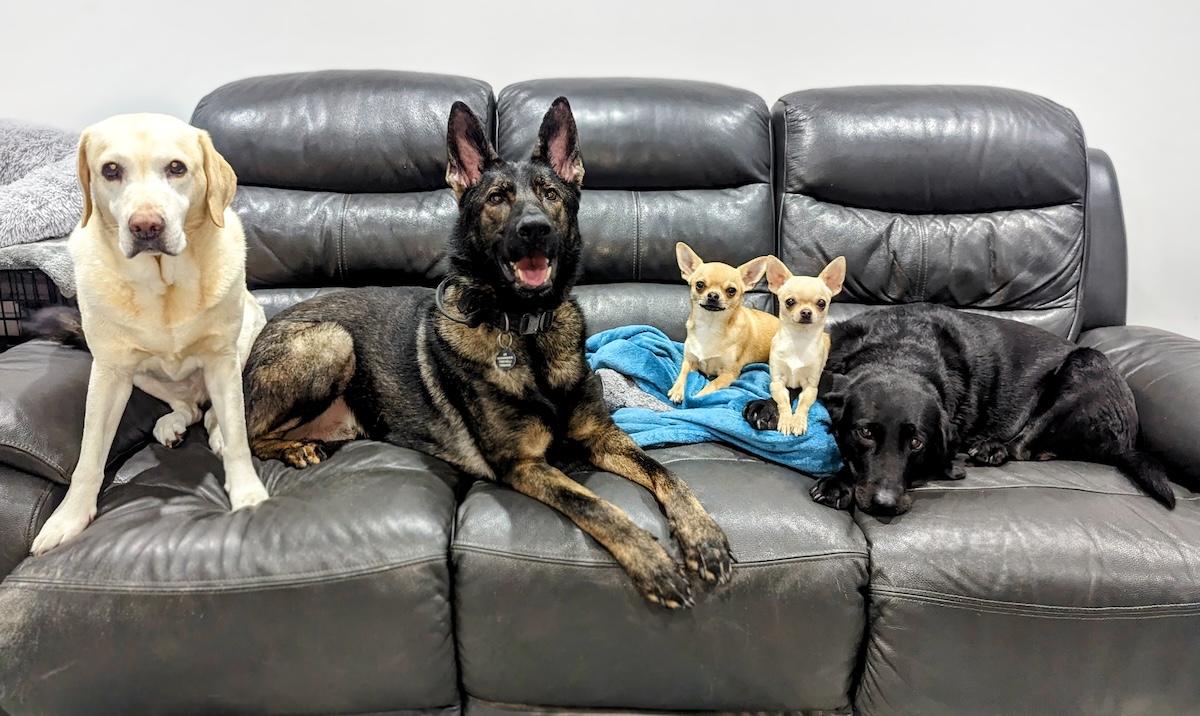Click to Skip Ahead
Most people associate the term “lupus” with the severe auto-immune disease that affects people; this form of lupus is systemic, meaning it reaches many different organs in the body. Thankfully, the most common form of lupus in dogs is not as severe or life-threatening. The canine lupus to which we are referring is discoid lupus erythematosus (DLE).
This is an immune-mediated (or auto-immune) condition that is generally confined to the nose and skin. This article will explain what DLE is, what we know and do not know about it, and how to care for a dog afflicted by this condition.

What is Discoid Lupus Erythematosus in Dogs?
DLE is an auto-immune condition in which the body starts attacking its own DNA. It is also sometimes referred to as cutaneous lupus erythematosus—cutaneous meaning it is confined to the skin. In DLE, the body is not going around attacking the DNA in all cells of the body.
Rather, the immune system identifies floating DNA in dead skin cells and targets its attack here. Most dogs are affected only on the nose, where DLE causes skin to slough or fall off.
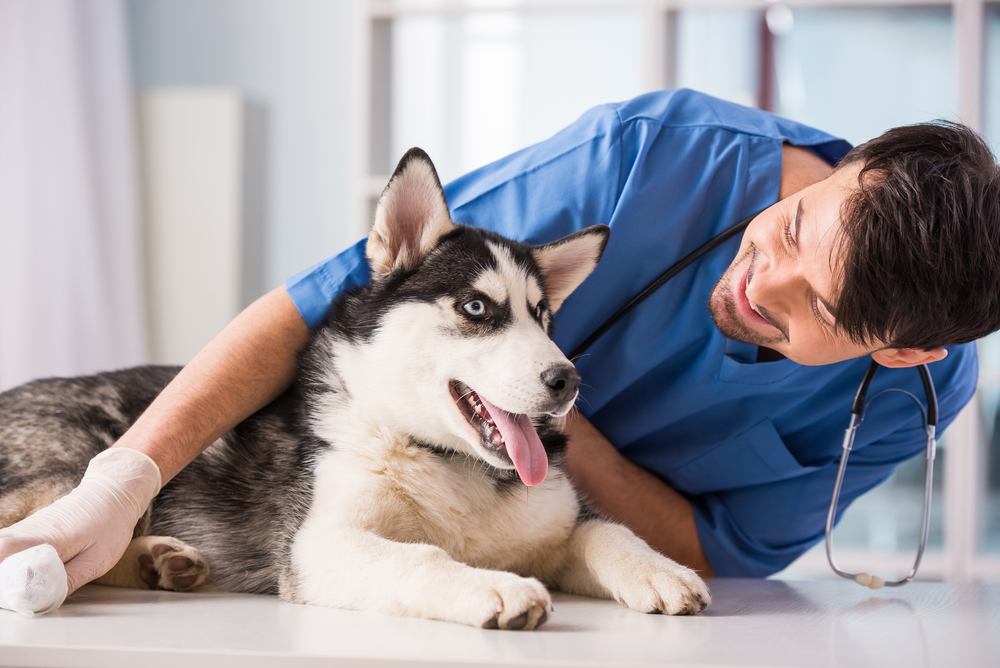
What Are the Signs of Discoid Lupus Erythematosus in Dogs?
Signs of DLE generally occur around the face and nose.
- Loss of normal “cobblestone” appearance of the nose
- Loss of pigmentation of the nose
- Crusting and thickening of the skin on the nose
- Ulceration and bleeding from the nose
- Pain and discomfort at the nose
While the vast majority of cases will affect only the nose, some dogs will develop similar lesions on the skin around their eyes, and on the footpads.
What Are the Causes of Discoid Lupus Erythematosus in Dogs?
In short, we still do not understand what exactly causes DLE in dogs. It is known to be an auto-immune condition, meaning the immune system mounts an inappropriate response to its own cells. For some reason, the body recognizes the DNA in dead skin cells as foreign material and attempts to get rid of it.
We also know that certain breeds appear more prone to developing DLE than others. German Shorthaired Pointers (GSP), German Shepherd Dogs, Collies, and Shetland Sheepdogs are affected by DLE most commonly. It is important to note, however, that DLE can affect any breed of dog.
Additionally, DLE is both associated with and aggravated by, ultraviolet light (UV light). This is a form of radiation emitted by the sun, so dogs that spend lots of time outdoors during the day may be more likely to acquire DLE.
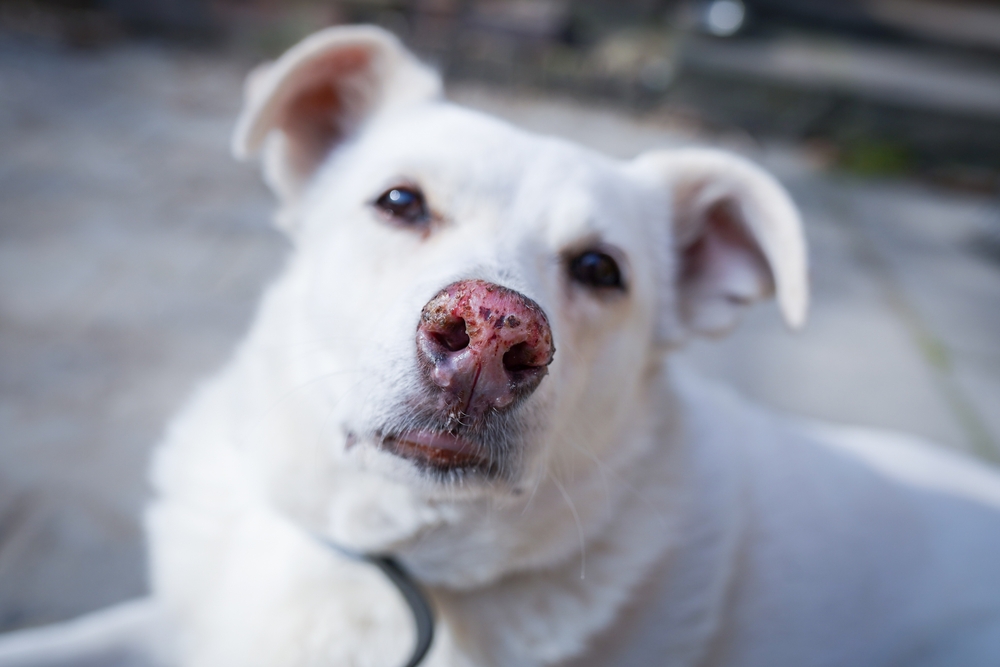
How Do I Care for a Dog with Discoid Lupus Erythematosus?
If you have noticed changes around your dog’s nose, arrange a consultation with your veterinarian. They will discuss the different diagnostic and treatment options with you.
- Topical medications. Topical medications refer to those applied directly to the nose. Tacrolimus or steroid ointments can be effective, either by themselves or in conjunction with the below medications. The challenge with topical medications is that dogs have a tendency to lick them off the nose before they can be absorbed.
- Immune suppression. This refers to tablets or capsules given orally to shut off the body’s immune response to its own DNA. Prednisolone and cyclosporine can both be used. Side effects are relatively common and should be discussed with your veterinarian.
- Vitamin supplementation. Many vets and vet dermatologists recommend niacinamide for dogs suffering from DLE. This is a B-vitamin supplement that has been used in conjunction with doxycycline (an antibiotic) to achieve good results.
- Antibiotics. Some dogs with DLE will have secondary skin infections of the nose. This occurs because the skin barrier is broken and compromised, allowing bacteria to enter and cause infection.
- UV light exposure. As we mentioned, UV light is known to trigger and aggravate DLE. Though it is certainly challenging, keeping dogs indoors during the sunny hours of the day is an important part of keeping DLE at bay.
There are two important factors to consider when treating DLE. Firstly, this is a lifelong condition; while there is no cure, it can usually be successfully managed with minimal or zero signs of disease.
Secondly, every dog requires slightly different treatment. What works for one dog may not work for another dog, so “trial and error” is an important part of finding the right treatment protocol.
PangoVet. It’s an online service where you can <b>talk to a vet online</b> and get the personalized advice you need for your pet — all at an affordable price!
</p>
<div class="su-button-center"><a href=https://www.dogster.com/ask-the-vet/"https://pangovet.com/?utm_source=dogster&utm_medium=article&utm_campaign=dog_preventative_wellness%22 class="su-button su-button-style-default" style="color:#FFFFFF;background-color:#FF6600;border-color:#cc5200;border-radius:9px;-moz-border-radius:9px;-webkit-border-radius:9px" target="_blank" rel="nofollow"><span style="color:#FFFFFF;padding:0px 24px;font-size:18px;line-height:36px;border-color:#ff944d;border-radius:9px;-moz-border-radius:9px;-webkit-border-radius:9px;text-shadow:none;-moz-text-shadow:none;-webkit-text-shadow:none"> Click to Speak With a Vet</span></a></div></div></div>"}" data-sheets-userformat="{"2":4224,"10":2,"15":"Arial"}" data-sheets-validation-definition="{"1":{"1":{"1":23,"2":[{"1":1,"3":{"1":{"1":[{"1":4,"6":1},{"1":1,"2":"="}]},"2":{"1":[{"1":2,"2":"="},{"1":3,"3":1}]},"3":"R1]S"},"4":[{"1":{"1":1,"2":21,"3":0,"4":1,"5":2236944,"6":"841046713"},"2":1}]}],"6":[{"1":{"2":{"1":2,"2":"🛡️ Flea & tick"}},"2":{"1":2,"2":676776},"3":{"1":2,"2":12574966}},{"1":{"2":{"1":2,"2":"❤️ Preventative wellness"}},"2":{"1":2,"2":676776},"3":{"1":2,"2":12574966}},{"1":{"2":{"1":2,"2":"⚠️ Urinary problems"}},"2":{"1":2,"2":676776},"3":{"1":2,"2":12574966}},{"1":{"2":{"1":2,"2":"👁️ Eye issues"}},"2":{"1":2,"2":676776},"3":{"1":2,"2":12574966}},{"1":{"2":{"1":2,"2":"🩺 Other"}},"2":{"1":2,"2":676776},"3":{"1":2,"2":12574966}},{"1":{"2":{"1":2,"2":"🍎 Ate or drank"}},"2":{"1":2,"2":676776},"3":{"1":2,"2":12574966}},{"1":{"2":{"1":2,"2":"🐕 Behavior & training"}},"2":{"1":2,"2":676776},"3":{"1":2,"2":12574966}},{"1":{"2":{"1":2,"2":"🤮 Vomiting"}},"2":{"1":2,"2":676776},"3":{"1":2,"2":12574966}}]},"2":{"1":{"1":[{"1":4,"6":0},{"1":4,"6":1},{"1":2,"3":"CONDITION_ONE_OF_RANGE","4":2},{"1":1,"2":"="}]},"3":"R0]R1]FCONDITION_ONE_OF_RANGE:2]S"},"3":[{"1":{"1":0,"2":1,"3":0,"4":1,"5":1118464},"2":0},{"1":{"1":1,"2":21,"3":0,"4":1,"5":2236944,"6":"841046713"},"2":1}]},"2":"","3":1,"4":1,"6":0}" data-sheets-validation-id="0"> If you need to speak with a vet but can’t get to one, head over to PangoVet. It’s an online service where you can talk to a vet online and get the personalized advice you need for your pet — all at an affordable price!

Frequently Asked Questions (FAQ)
How is DLE diagnosed?
DLE is diagnosed via a biopsy of some tissue on the nose. This requires general anesthesia. Samples are then sent to the laboratory for analysis by a pathologist. Biopsy is an important part of diagnosing DLE, and then establishing an effective treatment plan. This is because other conditions, including pemphigus, ringworm, and deep-skin infections, can appear similar to DLE, though they are treated very differently.
How Long Does Treatment Take?
There is no cure for DLE, meaning it needs to be managed for life. Once the initial lesions are under control, your vet will begin tapering the medications to find the lowest effective dose of each that will keep your dog free of any of the signs of DLE.
What Is the Prognosis for Dogs with DLE?
The prognosis for dogs with DLE is very good. Most dogs can be managed successfully for life, with only the occasional flare-up of nose lesions. DLE is not a life-threatening condition, though it will cause dogs significant pain and itchiness if left untreated.

Conclusion
Discoid lupus erythematosus is an auto-immune condition causing crusting and ulceration of a dog’s nose. Prompt diagnosis and effective treatment require you to work closely with your veterinarian. This condition can usually be well managed.
Featured Image Credit: Alexandra Morosanu, Shutterstock

